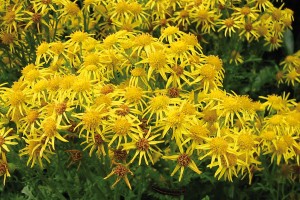Ragwort cinnabar moth

Image: male and female cinnabar moths. Photo credit: Mariusz401, License: CC BY 3.0
History in New Zealand
The cinnabar moth was imported from England by the Cawthron Institute in 1926 and released extensively throughout New Zealand from 1929-1932. Most of the original populations died out except in the southern North Island. Moths were collected from this thriving population in the 1980s, bred in large numbers, and re-released throughout the country. As a result, the cinnabar moth now occurs patchily throughout most areas of New Zealand where ragwort occurs and is more common some years than others.
How would I find/recognise it and what is its lifecycle?

Image: cinnabar moth adult. Photo credit: © Robert Briggs, license: (CC-BY-SA)
You may see cinnabar moths flying around ragwort infestations in spring and early summer. They are brownish-black with striking red markings and about 2 cm long. If you examine the undersides of ragwort leaves you should see clusters of their spherical yellow eggs. The eggs take about a fortnight to hatch into tiny, inconspicuous, yellowish caterpillars.

Image: cinnabar moth eggs. Photo credit: (c) Rand Workman, license: (CC BY-SA)
You will find the caterpillars easier to see as they grow and develop smooth, bold, yellow and black stripes, and migrate to the upper parts of the plant to feed. The best time to look for them is from December to February.

Image: cinnabar moth caterpillars. Photo credit: (c) Christopher Stephens, license: (CC BY-SA)
About 1 month after hatching, fully fed caterpillars crawl off to pupate. You are unlikely to see the brown pupae as they are usually well hidden, close to the ground, in a sheltered crevice.
Cinnabar moths are easy to differentiate from other ragwort biocontrol agents or insects on ragwort. The native magpie moth (Nyctemera annulata), which is also found on ragwort, is most commonly confused with the cinnabar moth. Magpie moth adults are brownish-black with white markings, and their pale yellow eggs are difficult to distinguish from cinnabar moth eggs. You will readily recognise the moths' "woolly bear" caterpillars by their long black bristles and predominantly black coloration. Although magpie moth sometimes completely strips leaves and flowers from ragwort plants, its impact is limited by heavy parasitism.
See Ragwort flea beetle, Ragwort plume moth, Ragwort seed fly.
Also, see Insects commonly mistaken for biocontrol agents.
How does it damage ragwort?
Cinnabar caterpillars damage ragwort by feeding on the leaves and flowers. The severity of the attack depends on the number of caterpillars and can vary from a few damaged leaves to bare stalks. If the damaged plants have to cope with additional stresses, e.g. drought, they may die, otherwise, they will usually regrow.
Will it attack other plants?
Cinnabar moth caterpillars have occasionally been seen feeding on closely related Senecio species if they are nearby and caterpillars have completely defoliated all the ragwort and are desperate for food.
How effective is it?
The cinnabar moth caterpillars can completely defoliate ragwort plants but these generally recover and there is little impact on plant populations from cinnabar attack.
Image: cinnabar caterpillar damage.
How can I get the most out of it?
Cinnabar moths disperse slowly, usually moving less than 1 km in 5 years. You can accelerate dispersal by collecting caterpillars from well-established sites and relocating them to new areas.
How do I select a release site?
Read Guidelines for selecting release sites for biocontrol agents.
How do I collect it for release at other sites?
Cut ragwort leaves with medium-large caterpillars on them and put these in a chilly bin or paper rubbish bag. The more caterpillars you can shift, the greater the chance that they will establish, and we recommend releasing at least 2,000. At the release site, wedge the cut material into large ragwort plants so the caterpillars can crawl across onto new plants. Do not overload plants by putting too many caterpillars on them (10-20 caterpillars are plenty for a large plant).
How do I manage the release sites?
The cinnabar moth does not establish well in some areas. The moths and caterpillars may be eaten by birds, and the pupae are sometimes parasitised by a species of wasp. Nothing can be done to prevent these natural events, but you may be able to enhance survival by providing some old logs for pupation. Pupal mortality is high under waterlogged conditions, and moths have a better chance of survival if there are places nearby where caterpillars can pupate and spend winter under dry conditions.
Do not throw good after bad. If you release a large number of caterpillars at an apparently good site, at the right time of the year, under favourable conditions, and this fails, then it may be better to try a different site next time.
Ensure that the ragwort at the release point is not heavily grazed or sprayed with herbicide.
